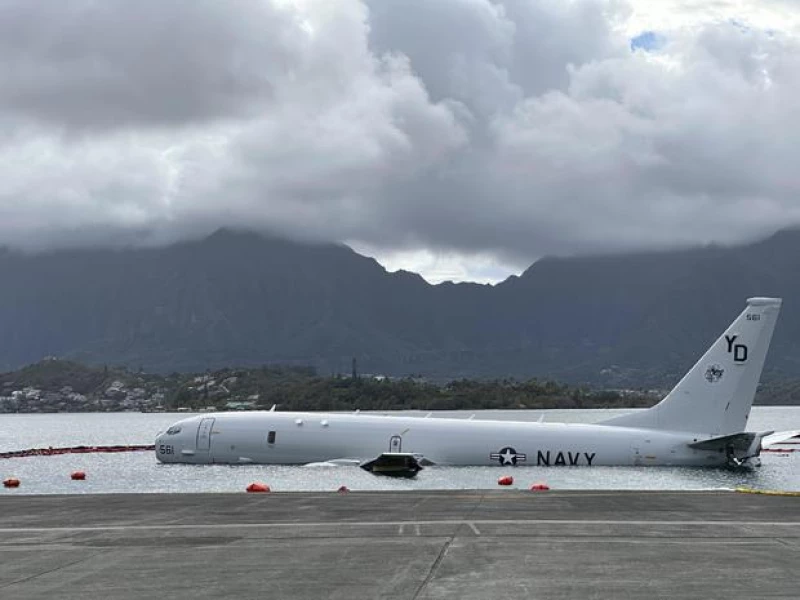U.S. Navy Removes Fuel from Plane Stranded in Hawaii Bay
The U.S. Navy announced on Monday that it has successfully removed almost all of the fuel from a large surveillance plane that overshot a runway in Hawaii and landed in an environmentally sensitive bay. However, there is currently no set timetable for the removal of the aircraft from the water. The incident occurred one week ago in Kaneohe Bay, located along the northeastern coast of the Hawaiian island of Oahu, during rainy weather.
Rear Adm. Kevin Lenox confirmed that approximately 2,000 gallons of fuel were onboard the P-8A Poseidon aircraft. "The team managed to extract all the fuel from the tanks, and this process was completed without any fuel being released into the bay," Lenox stated during a news conference. He also emphasized that removing the fuel significantly reduces the risks associated with the ongoing salvage operation.
On November 20, a plane landed in shallow water just offshore of Marine Corps Base Hawaii at Kaneohe Bay. Fortunately, there were no injuries to the nine people on board. The cause of the incident is still unknown, according to Marine Corps spokesperson Gunnery Sgt. Orlando Perez.
A Navy mobile diving and salvage unit, led by Cmdr. Mark Anderson, is currently working at the site. The plane is resting on a mixture of coral and sand, with the left engine resting on coral. However, the plane rises slightly with the tide, so it is not fully weighing on the coral.
Kaneohe Bay is known for its coral reefs, ancient Hawaiian fishpond, and as a breeding ground for hammerhead sharks. Although there may be some minor damage to the coral, there are no "massive chunks missing," according to Anderson. The focus now is on stabilizing the plane and developing a plan for its removal. State environmental officials will conduct a damage assessment once the plane is removed.
The Navy is considering two options for moving the aircraft. The first option is to float it and bring it within range of a runway crane, where it can be lifted onto the runway and set down on its landing gear, which is still in good condition. The second option is to float it on top of cylinders and roll it up onto the runway.
Navy Prioritizes Safety and Environmental Protection in Salvage Operation
The Navy is currently engaged in a salvage operation for a P-8A aircraft that crashed off the coast. According to Navy spokesperson Lenox, there are three main priorities during this process: ensuring the safety of the salvage crew, protecting the environment, and preserving the aircraft's capability.
To prevent any potential fuel spill or contamination from polluting the ocean, the Navy has implemented three temporary floating barriers around the aircraft's resting spot. These barriers serve as a protective measure against any potential pollutants.
In addition to the floating barriers, the Navy has strategically placed absorbent material around the plane. This material helps in absorbing any potential pollutants and also provides early warning in case of petroleum spills. Furthermore, a skimmer is kept on standby to promptly remove any pollutants that may be detected.
As part of the salvage operation, sailors retrieved the data recorder and conducted a hydrographic survey to assess the structural integrity of the plane. These measures are essential in determining the best course of action for the salvage process.

The Navy's environmental stewardship and transparency have been under intense scrutiny in Hawaii. This follows an incident in 2021 where jet fuel leaked from a World War II-era fuel storage facility into Pearl Harbor's drinking water, resulting in physical ailments for thousands of Navy personnel, their dependents, and civilians. In response to mounting pressure, the Navy has agreed to drain the tanks, and the operation is currently underway.
The Navy has responded to concerns from the community regarding a recent incident involving one of their planes. The state of Hawaii's on-scene commander witnessed the defueling of the plane and requested additional protective measures, which the Navy promptly installed. The Navy is committed to transparency and addressing the community's distrust.
The plane in question is a P-8A, used by the Navy for submarine search, surveillance, and reconnaissance. Manufactured by Boeing, it is a military version of the 737 passenger jet. The size of the plane is comparable to the Airbus A320, which famously made an emergency landing on the Hudson River in 2009. Some have drawn similarities between the images of the Navy plane in Kaneohe Bay and the "Miracle on the Hudson."
The Navy plane is assigned to Patrol Squadron 4, known as the Skinny Dragons, stationed at Whidbey Island in Washington state. While patrol squadrons were once based at Kaneohe Bay, they now deploy to Hawaii on a rotating basis. Kaneohe Bay is home to several major military installations.
An aircraft expert, Peter Forman, has suggested that the mishap may have been influenced by the shorter runway at the base and adverse weather conditions.
"The pilot probably didn't put the plane down exactly where he wanted to on the runway," an aviation expert stated. "It's probably a combination of all those factors put together."
Following the incident, the Navy has dispatched another P-8A from Washington state to take over patrol duties while the damaged aircraft is incapacitated. The replacement aircraft is currently operating out of Joint Base Pearl Harbor-Hickam, located on the opposite side of Oahu.







